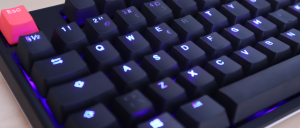
I write a lot on my keyboard. Every day. I do plenty of coding, documentation and also different type of content creation. Both for my own website but also for my work place website. I know I start to get old but somedays I can feel pretty rough in my neck and shoulders. Thus ergonomi starts to be pretty important for me. A few years ago I started to use a mechanical keyboard – a decision I will never regret. It is something very special to write on a keyboard that has really great tactile response. Now I start to look into finding ways to make my writing experience even better – not faster, but more economical on my aging limps. Let’s get started with it…
Our normal keyboards hasn’t really changed that much since in the end of the 19th century. The modern QWERTY-keyboard was taking it form around 1870 when it was invented by Christopher Latham Sholes when he designed the type writer. From the beginning it was a keyboard more like a piano, but as the mechanical design went forward the setup formed to the QWERTY-keyboard we have today. There is a common myth going around saying that the reason it ended up like this was mechanical and for the arms punching the color band onto the paper shouldn’t get jammed. This is however not a confirmed story. It could very well be so. It is also know that there was some research into character frequencies and word structure when the keyboard was designed. But all the details are not known.
The problem with the old QWERTY keyboard is that it is not very efficient. When you write you are forced to move you hands and fingers a lot. If you where to write out the old classic “Huckleberry Finn” you would move your fingers 14195 meters.
In the 1936 by August Dvorak to be the replacement of the old QWERT-keyboard layout. Its aim is to be faster and more ergonomic. This keyboard layout is probably the one most commonly known and used after QWERTY. If we again look at the Huckleberry Finn book – a type out with Dvorak would make your fingers travel 8369 meters. A significant improvement. Probably for many different reasons the keyboard layout never really took off – but there is quite a few users out there.
Since mechanical keyboards started to be more and more common additional layouts has been created to. Another very common layout is Colemak. The goal is to move as few keys as possible from the standard QWERTY layout as possible – 17 keys has been moved – to make it easier to learn and user. Most important the undo (Ctrl-Z), copy (Ctrl-C), cut (Ctrl-X) and paste (Ctrl-V) has not been affected and the muscle memory will still work. If we look at the Huckleberry Finn book again – with Colemak your fingers would travel 8132 meters. Still an improvement over Dvorak.
There is a variation of Colemak called Workman. It’s some additional keys that has been changed to limit the need of moving the fingers around. 21-keys has been changed compared to the original QWERTY-keyboard. But in the Huckleberry Finn book we would need to move our hands 7841 meters. This is a keyboard layout that really optimize how the keyboard is used for quick and easy access. This layout has been adjust to work specifically well for developers and systems administrators – e.g. the good folks that are living behind the keyboard hammering out text all day, every day.
There are also more layouts there. Some being created by computer programs by essentially calculating the most effective placement of the keys based on word and character data.
Full disclosure here. I am a QWERTY only write. But it is quite interesting with layouts and the promise to they provide to make it even easier and more effortless to type. I am a modest write – depending on my day form, but between 60 and 70 words a minute I can crank out. The reason for me would more be the easy of writing and less strain. Initially I would likely plummet to country probably more close to 10 words a minute. An additional challenge is that all these keyboard layouts have been designed for the english language. I write a lot in English – but I also write a lot in Swedish. And we have our special characters that I will then need to add to the keyboard. And usually when you make Colemak or workman Swedish, the special characters are placed on the side of the keyboard.
The keyboard layout that I think looks most interesting for me is the Workman layout. It is of course the effectiveness of it – that you will save a lot of energy while write. After that the ability to write with less error is important. Speed comes first later down the line. I write fast enough for it not to hinder my thought process.
I may be looking at doing a change to a new keyboard layout. But the timing of it needs to be right. I must have plenty of time so that I have time to practice.
That was a long talk about keyboard layouts. I hope you enjoyed the episode. Take it easy and until tomorrow “May the force be with you!”

